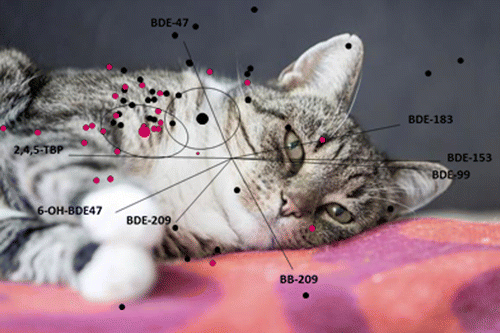Flame retardants could contribute to hyperthyroidism in older cats

For years, health advocates have been pushing to ban some flame retardants for their potentially harmful effects, especially on young children and infants. Now scientists report these compounds could play a role in a common health problem for one of our most beloved pets: cats. In the ACS journal Environmental Science & Technology, a new study found that cats with hyperthyroidism had high levels of certain flame retardants, hinting at a possible link.
Jessica Norrgran and colleagues explain that more than 10 percent of older cats develop hyperthyroidism, a hormonal disorder that can cause weight loss, hyperactivity, aggression, vomiting and other symptoms. In humans, the condition has been linked to Graves' disease and iodine deficiency. No one knows for sure what causes hyperthyroidism in cats. Some studies have suggested a connection between the feline condition and flame retardants. These substances leach from plastics and furniture, and accumulate in dust that can end up on cats' fur. The animals' meticulous grooming methods make them particularly susceptible to exposure to these compounds. Norrgran's team wanted to investigate this potential link further.
The researchers tested blood samples from pet felines in Sweden—37 hyperthyroid cats and 23 cats with normal thyroid function. They found that those with hyperthyroidism had elevated levels of flame retardants known as polybrominated diphenyl ethers (PBDEs). Although the results don't prove that the compounds cause the disorder, the study suggests they could be linked.
More information: Higher PBDE Serum Concentrations May Be Associated with Feline Hyperthyroidism in Swedish Cats, Environ. Sci. Technol., 2015, 49 (8), pp 5107–5114. DOI: 10.1021/acs.est.5b00234
Abstract
Serum from 82 individual cats was analyzed for decabromobiphenyl (BB-209), polybrominated diphenyl ethers (PBDEs), hydroxylated PBDEs (OH-PBDEs), and 2,4,6-TBP in order to study differences in body burden between healthy and sick cats diagnosed with Feline Hyperthyroidism (FH). Within the study group, 60 of these cats had a euthyroid (n = 23) or hyperthyroid (n = 37) status, all of which were used in the comparison. This study shows that hyperthyroid compared to euthyroid cats have higher serum concentrations for some of the investigated PBDEs (BDE-99, BDE-153, and BDE-183) and CB-153 on a fat weight basis. Further, it is intriguing, and beyond explanation, why the flame retardant BB-209 (discontinued in 2000) is present in all of the cat serum samples in concentrations similar to BDE-209. Median BDE-47/-99 ratios are 0.47 and 0.32 for healthy and euthyroid cats, respectively, which differs significantly from Swedes, where the ratio is 3.5. Another important finding is the occurrence of very low levels or the absence of hydroxylated PBDE metabolites in the cats. In addition, the major OH-PBDE, 6-OH-BDE47, is likely of natural origin, probably ingested via cat food. The statistics indicate an association between elevated PBDE concentrations in the cats and FH.
Journal information: Environmental Science & Technology
Provided by American Chemical Society













